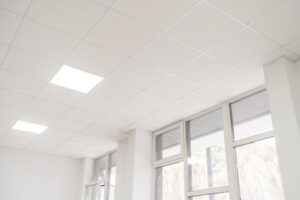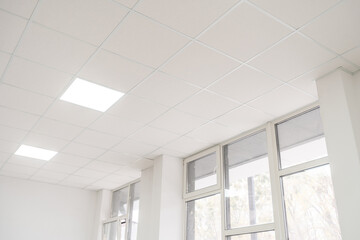The ceiling is often the most overlooked area of a room, but it can make or break the entire look. It is important to install it properly.
Acoustic Ceiling Installation involves a number of steps and can be quite complicated. It is best to get a professional to do it for you.
A few simple preparations make a big difference in the overall success of your ceiling project. They help you save time and ensure that your work is done as smoothly as possible.
Clear your workspace, lay down paper or canvas drop cloths, and remove furnishings from the room if possible. You should also grab yourself a ladder, brush, tape, roller, extension pole, and tray.
Drywall installation involves removing old wallpaper, plastering, and painting the walls and ceiling before installing new wall coverings. Drywall installers create drywall walls and ceilings from sheetrock or other materials such as fiberboard, gypsum board, or clay tile. They sand, smooth, and apply finishing compounds to the drywall surface before putting it into place.
They cut out openings in drywall for heating and air-conditioning sensors, sprinkler heads, light fixtures, and other fixtures. They also install wires to connect these fixtures and electrical outlets.
To prepare the walls and ceiling for ceiling tiles, acoustical carpenters follow blueprints and drawings to nail or screw metal moldings to the wall of a space. These moldings form a seal for the tiles, which are then attached to the ceiling using adhesives or clips.
During ceiling installation, it is important to keep track of the number of tiles in the grid. If there are more than a certain number of reference bars, you must cut the rest out of the grid. Afterward, you can complete the assembly of each reference bar by placing the tiles on the grid according to the environment.
Once the installation is complete, you can paint the ceiling with a stain-blocking primer to hide more flaws, cover over worn colors, and prevent any stain bleed-through. You can then start laying off the paint by applying it in 3-foot by 3-foot sections, overlapping the wet edges of each section to blend them together.
The layout of a suspended ceiling system is an important consideration, as it will influence how much material you’ll need to buy and the amount of time it takes to complete your project. With a little careful planning, you’ll be able to save yourself some headaches in the long run.
First, you’ll need to determine the room’s size. To do this, take accurate measurements of the floor, ceiling, and walls. Once you’ve got a good estimate, use graph paper to draw out the shape of your room.
You’ll want to start with the main runner and joist direction (as shown in this video) before moving on to equalizing the ceiling tile borders and maximizing your lighting layout. This will help you decide which main runner and joist system will work best for your space and give you a better idea of the number of wall angles, cross tees, and hanger wires you’ll need to purchase.
Next, figure out the number of full-sized tiles you’ll need. This is an easy way to ensure you’ll have enough tiles to cover your space as well as the right-sized cut panels.
For a smooth, polished look, plan on using at least one full-sized tile in each corner. This will allow you to create a symmetrical design that’s as beautiful as it is effective. Alternatively, you can go for a balanced, centered design that allows you to use fewer tiles while still giving the room a smooth, professional appearance. It’s also easier to cut tiles this way, as it eliminates any gaps between them. You’ll also have a cleaner job in the end, as it will be easier to clean up after installation.
The ceiling is one of the largest areas in any room that can be resurfaced for a variety of purposes, from sound dampening to aesthetic appeal. Tiles are used in ceiling installation to give rooms a finished look that complements the design theme. They come in different thicknesses, colors, and patterns, making it easy to find the right tile for any space.
Decorative tiles blend form and function, offering designs that are often fire-resistant and acoustic-absorbing. They are typically applied in spaces where aesthetics are important and ambient noise must be reduced, such as in offices, schools, and healthcare facilities.
These tiles are made from lightweight materials and can be applied directly to drywall or plaster surfaces using adhesives. They can also be installed using wood furring strips and nails or staples, depending on the materials of the ceiling.
Before laying down the tiles, clean the surface of the ceiling to remove dirt, dust, and other contaminants. This will make it easier for the tiles to stick to the surface and help them stay in place.
Once the ceiling is clean, use a foam brush or putty knife to spread a thin coat of cement or adhesive on the back of each tile. This will allow the tiles to bond to the ceiling and help them stand up to traffic.
After the cement or adhesive has been applied, place each tile in an even row on the ceiling surface. Then, use light to medium pressure to press each tile against the ceiling and into place.
Once all the tiles are in place, use self-adhering strips to cover any gaps between the tiles. This helps keep them in place and makes the job much faster.
A ceiling grid is the system that holds suspended or acoustical tiles. It is available in various types, shapes, designs, and colors to suit your needs.
The layout of the grid is determined by the room size, aesthetics, and functional requirements. It also determines the type of suspension system. It can be either exposed or concealed.
In older constructions, a plenum space was often used between the main ceiling and the grid to allow for ventilation. In new construction, closed ductwork is more common and less harmful to people and property.
It is important to keep the grid as far from light fixtures as possible. This will avoid shadowing and make the rooms brighter.
During installation, it is essential to level the grid. This is best done using a magnetic level. If necessary, raise or lower the cross tees and main beams to achieve a flat surface.
PRO TIP: QuickHang kits feature a system that eliminates the need to bend and twist wires, saving time. The grid hook slides into a bracket and can be adjusted up or down by squeezing the tabs.
If you plan on using a grid with wood planks, use Easy Up clips to hold the planks in place. The clips fit a 15/16-inch grid and have a hook that slips into the groove on the planks to secure them.
The grid system is a great choice for a drop ceiling because it allows for easy access to the plenum to perform wiring and piping changes. In addition, it is easier to change the ceiling tiles or other components of a grid system than to do so behind traditional plaster or wallboard ceilings.
Ceiling installation requires a high level of technical skills and knowledge. It is a skill-level 2 occupation. This means that it is often possible to acquire some of the required skills and knowledge by undertaking informal on-the-job training and/or experience, as well as completing relevant qualifications.
During ceiling installation, it is important to ensure that the structure is stable and that the ceiling is installed in a way that minimizes the risk of accidents. This is done by using safety equipment and ensuring that the work area is clean and tidy.
Before starting a ceiling installation, it is necessary to map out the room and make sure that the layout is correct. This will help you determine where to start, what size panels to cut, and how they should be positioned.
It is also important to ensure that the layout is balanced by locating and drawing light fixtures, heating vents, and other features. These may affect the starting point, tile placement, and finish ceiling design.
After mapping out the layout of the room, it is time to start installing the drywall. This is a complex job that needs to be completed by two people, as it is very heavy and dangerous work.
Once the drywall is in place, it is time to install the joists and wall molding. It is a good idea to use a level to ensure that the joists are all at the same height and that they are lined up with the walls.
